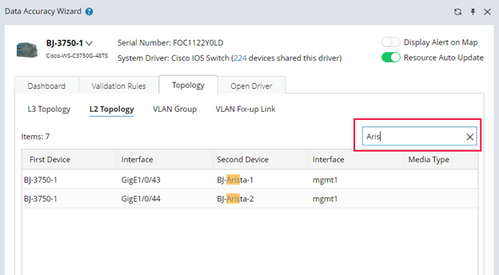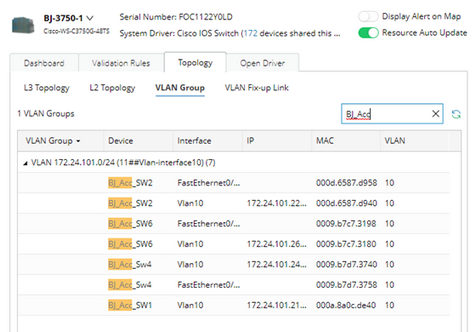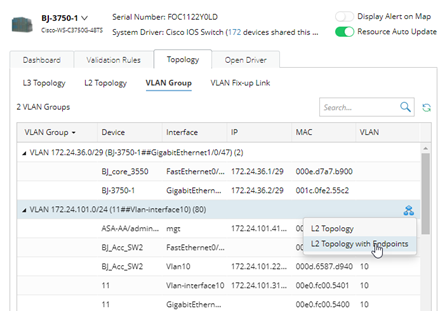Managing Topology with Open Topology
Open Topology improves the topology calculation algorithm for better accuracy and incorporates users’ input in the calculation process for better maintenance.
Open Topology takes the data from the network such as MAC table and routing neighbors as well as the user input to calculate the VLAN Groups and build L3 and L2 topology on top of them.
With Data Accuracy Wizard, you are able to :
•view L2 Topology for a specific device
•view VLAN Group for a specific device
•view and add VLAN Fix-up Link for a specific device
View L3 Topology for a specific device
1.Click Data Accuracy Wizard on the left Menu Bar from the Desktop.
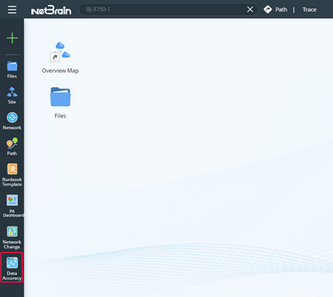
2.Click  icon right after the Device Name, and search for the device you want to view.
icon right after the Device Name, and search for the device you want to view.
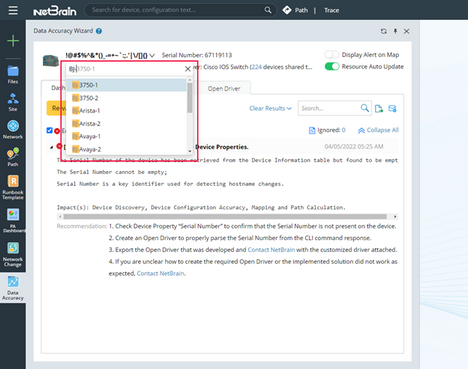
3.Click on Topology tab and then click on L3 Topology.
Under L3 Topology Tab, the table shows all the L3 Neighbors that belong to the current device.
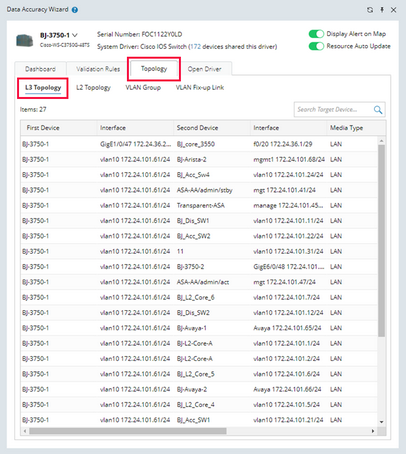
Note: For multi-ports connections, this table will display them via several port-to-port links.
Explanations for L3 Topology Table Properties
First Device |
The Hostname of the Current Device. |
Interface |
The Interface Name of the Current Device. |
Second Device |
The Hostname of the Neighbor Device. |
Interface |
The Interface Name of the Neighbor Device. |
Media Type |
Media represents multi point link. NetBrain support couple type of media: LAN, WAN, DMVPN, and more. |
Create by |
How the L3 Topology Link is created. Common resources include System, Qapp, Plugin, admin, and more. |
Source |
How the L3 Topology Link is calculated. Common resources include Interface IP Address, Qapp, Plugin, Manually Add, and more. |
Update Time |
The latest L3 Topology Link update time |
Search L3 Topology Table Properties
Tips:
-Search function is not case sensitive.
-You are able to search for properties from all columns.
Map from L3 Topology Table
You are able to select single or multiple items and map them out.
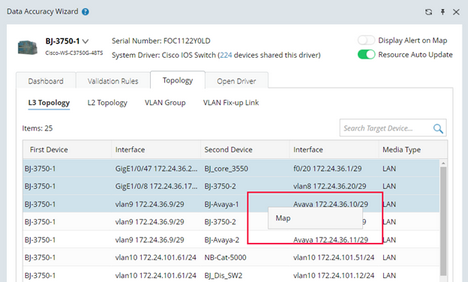
View L2 Topology for a specific device
1.Click Data Accuracy Wizard on the left Menu Bar from the Desktop.

2.Click  icon right after the Device Name, and search for the device you want to view.
icon right after the Device Name, and search for the device you want to view.

3.Click on Topology tab and then click on L2 Topology.
Under L2 Topology Tab, the table shows all the L2 Neighbors that belong to the current device.
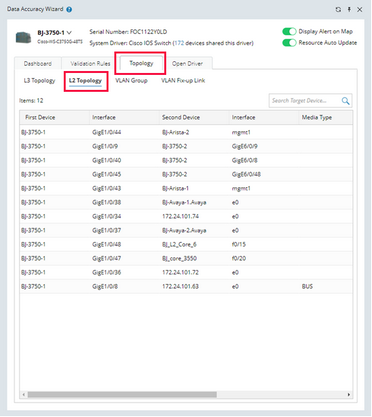
Note: For multi-ports connections, this table will display them via several port-to-port links.
Explanation for L2 Topology Table Properties
First Device |
The Hostname of the Current Device. |
Interface |
The Interface Name of the Current Device. |
Second Device |
The Hostname of the Neighbor Device. |
Interface |
The Interface Name of the Neighbor Device. |
Media Type |
Media represents multi point link. NetBrain support couple type of media: BUS, LAG, and more. |
Create by |
How the L2 Topology Link is created. Common resources include System, Qapp, Plugin, admin, and more. |
Source |
How the L2 Topology Link is calculated. Common resources include NDP Table, ARP Table, Configuration File (Device Interface), Qapp, Plugin, Manually Add. |
Update Time |
The latest L2 Topology Link update time |
Search L2 Topology Table Properties
Tips:
-Search function is not case sensitive.
-You are able to search for properties from all columns.
Map from L2 Topology Table
You are able to select single or multiple items and map them out.
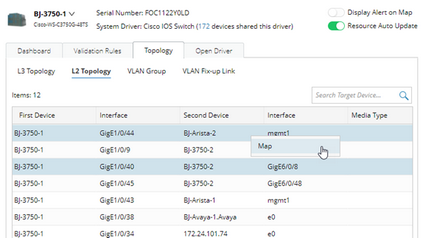
View VLAN Group for a specific device
VLAN Group is an L2 Broadcast Domain, including L3 IP Interface, L2 Switchport, and End Point (End System and MAC Device). It is often associated with a business unit, for example, Dev VLAN, QA VLAN, etc. The IP addresses in a VLAN Group should not be duplicated except HA(High Availability) and FHRP(First Hop Redundancy Protocol).
1.Click Data Accuracy Wizard on the left Menu Bar from the Desktop.

2.Click  icon right after the Device Name, and search for the device you want to view.
icon right after the Device Name, and search for the device you want to view.

3.Click on Topology tab and then click on VLAN Group.
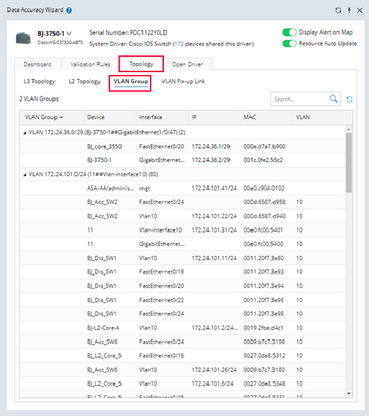
VLAN Group Table Properties
VLAN Group |
Name of the VLAN Group |
Device |
Hostname of the device in the VLAN Group |
Interface |
Interface name of the device in the VLAN Group |
IP |
IP address of the Device Interface. If this is a L2 Interface, this column keep blank |
MAC |
MAC address of the Device Interface. |
VLAN |
VLAN ID of the Device Interface in the current VLAN Group |
Search VLAN Group Table Properties
Tips:
-Search function is not case sensitive.
-You are able to search for properties from all columns.
Map from VLAN Group Table
We provide 2 ways to map a selected VLAN GROUP:
1.L2 Topology:
Click the VLAN Group Name and then click the Map icon ![]() on the right. Select L2 Topology from the menu, then all the network devices from the VLAN Group will be mapped out as L2 Topology.
on the right. Select L2 Topology from the menu, then all the network devices from the VLAN Group will be mapped out as L2 Topology.
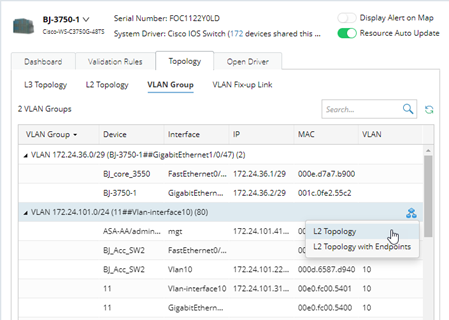
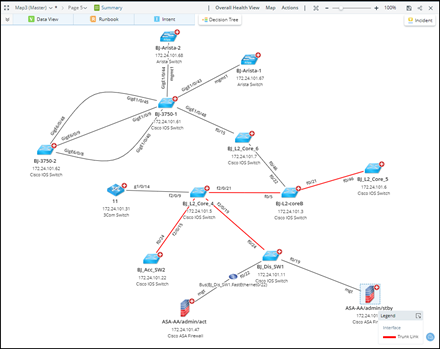
2.L2 Topology with Endpoints
Click the VLAN Group Name and then click the Map icon ![]() on the right. Select L2 Topology with Endpoints from the menu, then all the network devices and Endpoints from the VLAN Group will be mapped out as L2 Topology.
on the right. Select L2 Topology with Endpoints from the menu, then all the network devices and Endpoints from the VLAN Group will be mapped out as L2 Topology.
View and Add VLAN Fix-up Link for a specific device
You can manually add the Fix-up links between neighbor interfaces to help to improve the VLAN Group calculation on following situation: the device does not support NDP or NDP disabled on the device. For example: Cisco ASA Firewall use physical interface connected to a L2 switch port.
1.On the Data Accuracy Wizard window, click on Topology tab and then click on VLAN Fix-up Link.
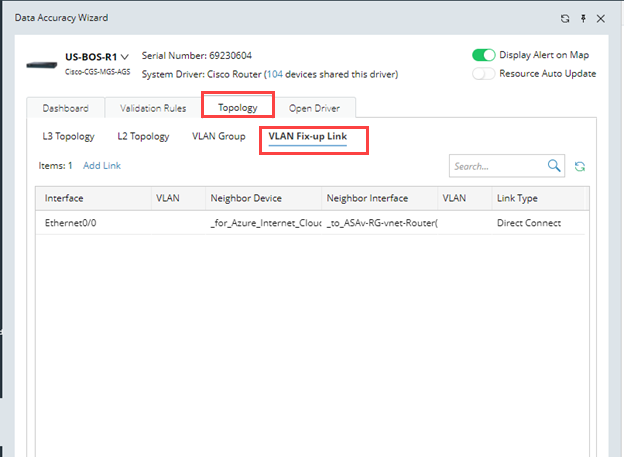
2.Click on Add Link to open the window.
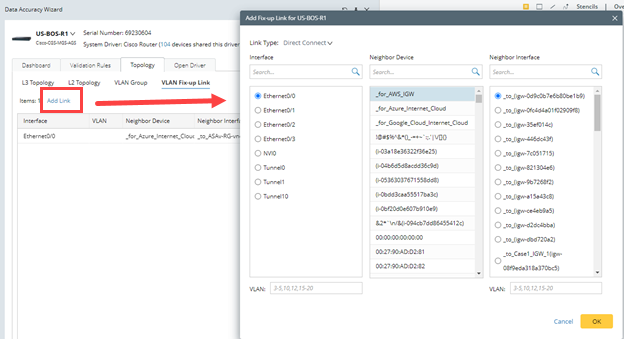
3.Select the link type, then search and select the device interface and the neighbor interface to add the link.
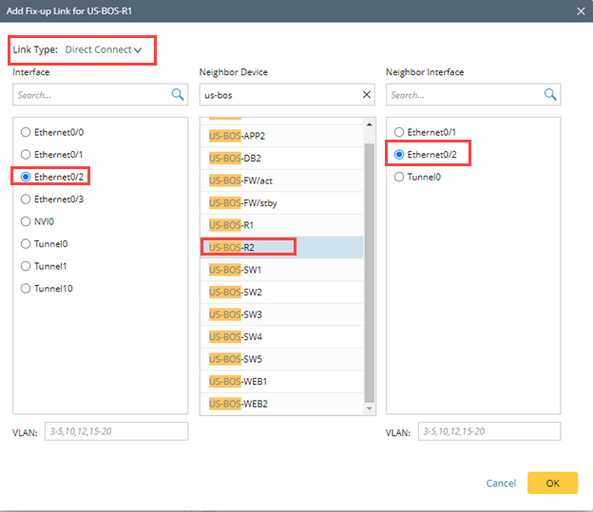
There are two Link Types:
•Direct Connect will affect both VLAN group and L2 topology
•Virtual Connect only affects the calculation of VLAN groups. The Virtual Connect is designed to support Overlay technology such as OTV and VxLAN.
Note:You will need to enter the interface VLANs for both sides of the link:

1. If you only add one VLAN ID for each side of the link, the interfaces will be treated as access ports. In this case, the VLAN ID for each side could be either the same or different.
2. If you only add VLAN Range for each side of the link, the interfaces will be treated as trunk ports. In this case, the VLAN ID for each side must be the same. You can use “,” to separate VLANs for a VLAN Range, and use “-” to indicate the range of a VLAN. For example: 2,4,6-9,11-19.
See also:


